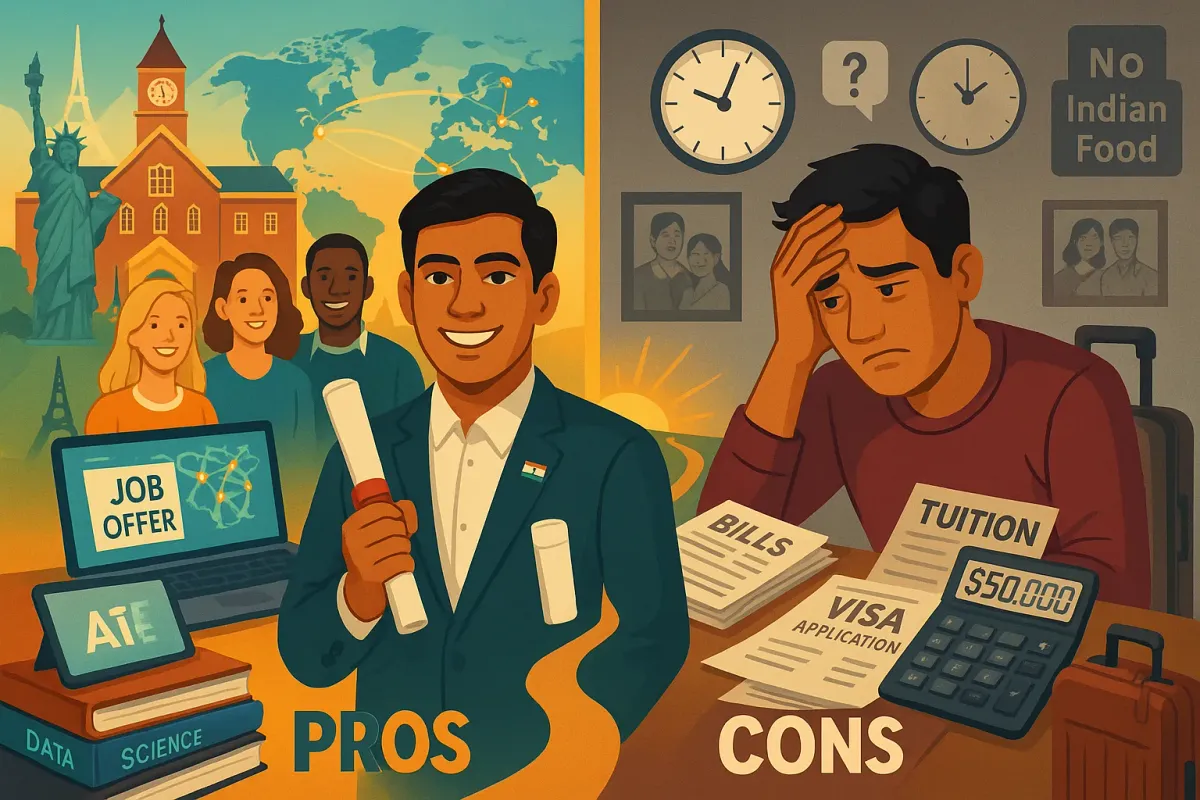Foreign Education for Indian Students: Pros and Cons
Studying abroad is a dream for many Indian students, promising world-class education, global exposure, and career opportunities.

Studying abroad is a dream for many Indian students, promising world-class education, global exposure, and career opportunities. However, it also involves financial, emotional, and logistical challenges. This guide explores the pros and cons of foreign education for Indian students, detailing how it can shape their future and the potential pitfalls to watch out for.
Pros of Studying Abroad for Indian Students
1. Access to World-Class Education
- Top Institutions: Universities like Harvard, MIT, Oxford, or Stanford offer cutting-edge facilities, renowned faculty, and innovative teaching methods unavailable in many Indian institutions.
- Specialized Programs: Fields like AI, robotics, data science, or niche areas like sustainable architecture are often more advanced abroad. For example, programs in computer science at MIT or Stanford include hands-on projects with industry giants like Google or Microsoft.
- Research Opportunities: Many foreign universities emphasize research, offering Indian students access to state-of-the-art labs and funding. For instance, PhD students in the US often receive stipends (e.g., $30,000–$40,000 annually) and work on groundbreaking projects.
- Flexible Curriculum: Unlike India’s rigid academic structure, countries like the US allow students to explore diverse subjects before declaring a major, fostering interdisciplinary learning.
2. Global Exposure and Cultural Growth
- Diverse Network: Indian students interact with peers from across the globe, building a network that can lead to international job opportunities or collaborations. For example, an Indian student at London Business School might connect with future CEOs from Europe or Asia.
- Cultural Adaptability: Living in a new country exposes students to different lifestyles, cuisines, and traditions, broadening their worldview. For instance, celebrating Thanksgiving in the US or Diwali with an international community fosters cultural fluency.
- Language Skills: Studying in English-speaking countries like the US, UK, or Australia sharpens English proficiency, a critical skill for global careers. Non-English-speaking countries like Germany or France offer a chance to learn German or French, enhancing employability.
3. Enhanced Career Opportunities
- Global Job Market: A degree from a prestigious foreign university carries weight worldwide. For example, an IIT graduate with an MBA from INSEAD (France) is more likely to land a role at McKinsey or Goldman Sachs than someone with only a local degree.
- Internships and Industry Connections: Universities abroad often have strong industry ties. For instance, US universities offer Optional Practical Training (OPT), allowing students to work for 1–3 years post-graduation, often leading to H-1B visa sponsorship.
- Higher Salaries: Graduates from top foreign universities often earn significantly more. For example, a software engineer with a US degree might start at $100,000 annually, compared to ₹10–15 lakh ($12,000–$18,000) for an Indian graduate.
- Entrepreneurial Opportunities: Countries like the US or Canada have vibrant startup ecosystems. An Indian student studying at Stanford might join a Silicon Valley startup or launch their own, leveraging local venture capital networks.
4. Personal Development
- Independence and Resilience: Moving to a new country forces Indian students to manage finances, cook, and navigate bureaucracy, fostering independence. For example, handling US taxes or UK tenancy agreements builds life skills.
- Confidence and Adaptability: Overcoming challenges like homesickness or cultural differences builds mental toughness. An Indian student in Australia might learn to advocate for themselves in unfamiliar academic or social settings.
- Global Perspective: Exposure to diverse viewpoints—such as debates on global issues in a UK classroom—helps Indian students think critically and approach problems creatively.
5. Immigration Pathways
- Post-Study Work Visas: Countries like Canada (Post-Graduation Work Permit, up to 3 years), Australia (Temporary Graduate Visa, 2–4 years), or the UK (Graduate Route, 2 years) allow Indian students to stay and work after graduation, potentially leading to permanent residency.
- Skilled Migration: Countries like Canada and Australia prioritize skilled graduates for immigration. For example, an Indian student with a Canadian master’s degree in engineering can score high points on the Express Entry system for permanent residency.
Cons of Studying Abroad for Indian Students
1. High Financial Costs
- Tuition Fees: Tuition in the US can range from $30,000 to $60,000 per year for undergraduate programs and $40,000–$80,000 for graduate programs. In the UK, fees are £15,000–£35,000 ($20,000–$46,000) annually. For an Indian student, this translates to ₹25–60 lakh per year, a massive burden for middle-class families.
- Living Expenses: Rent, food, and transport add up. For example, living in London costs £1,200–£2,000 monthly ($1,600–$2,600), while US cities like Boston or New York average $1,500–$2,500 monthly. Total annual costs can hit ₹40–70 lakh.
- Limited Scholarships: While merit-based scholarships exist (e.g., Fulbright for the US or Chevening for the UK), they’re highly competitive. Indian students often rely on education loans, with interest rates of 10–14%, leading to repayments of ₹50 lakh or more over 10 years.
- Currency Exchange Impact: The weakening Indian rupee (e.g., ₹83 to $1 as of 2025) makes expenses even steeper, straining family finances.
2. Culture Shock and Emotional Challenges
- Homesickness: Indian students often miss family, festivals like Diwali, and familiar foods like dal-chawal. For example, a student in Germany might struggle to find authentic Indian groceries or community events.
- Cultural Differences: Adjusting to new social norms—like direct communication in the US or reserved behavior in the UK—can be jarring. Indian students may feel isolated if they don’t quickly integrate.
- Discrimination: Some Indian students face subtle or overt racism, such as being stereotyped or excluded. For instance, in smaller US or European towns, locals may be less welcoming to international students.
- Mental Health Strain: The pressure of academics, finances, and social isolation can lead to anxiety or depression. Access to mental health support abroad is often expensive (e.g., $100–$200 per therapy session in the US) and may not be culturally sensitive.
3. Visa and Immigration Challenges
- Complex Visa Processes: Securing a student visa (e.g., F-1 for the US, Tier 4 for the UK) requires extensive documentation, interviews, and proof of funds (e.g., $40,000 in a bank account for a US visa). Delays or rejections can derail plans.
- Post-Study Work Restrictions: In the US, OPT allows only 1–3 years of work, and securing an H-1B visa is a lottery with a 15–30% approval rate. Indian students face fierce competition from global applicants.
- Deportation Risk: Violating visa rules (e.g., working off-campus without permission) can lead to deportation, wasting years of investment. For example, an Indian student in Canada was deported in 2023 for unknowingly breaching visa conditions.
4. Recognition of Foreign Degrees in India
- Limited Recognition: Some Indian employers or government bodies (e.g., for public sector jobs) may not value foreign degrees without additional certifications. For instance, a US medical degree requires clearing the FMGE (Foreign Medical Graduate Examination) to practice in India, with a pass rate of only 10–20%.
- Relevance Mismatch: Degrees in niche fields like creative writing or environmental policy may have limited applicability in India’s job market, forcing graduates to pivot careers.
- Additional Costs: Obtaining equivalency certificates from bodies like the Association of Indian Universities (AIU) can be time-consuming and costly, with fees up to ₹50,000.
5. Academic and Social Pressures
- Rigorous Academics: Foreign universities often have intense workloads. For example, a master’s in engineering at MIT might require 60–80 hours of weekly study, overwhelming students used to India’s exam-focused system.
- Social Integration: Indian students may struggle to fit into peer groups dominated by locals or other internationals. For instance, group projects in Australia might be challenging if teammates don’t understand Indian accents or cultural references.
- Time Zone Challenges: Staying connected with family in India is tough due to time differences (e.g., 9.5 hours between India and the US West Coast), leading to feelings of disconnection.
How Studying Abroad Benefits Indian Students
- Career Advancement: A foreign degree can open doors to multinational companies like Amazon, Deloitte, or Infosys, which value global credentials. Indian students with foreign MBAs often secure roles with salaries 2–3 times higher than local graduates.
- Skill Development: Exposure to project-based learning, critical thinking, and interdisciplinary studies equips Indian students with skills like problem-solving and innovation, which are less emphasized in India’s rote-learning system.
- Global Citizenship: Living abroad fosters adaptability and cultural sensitivity, making Indian students competitive in a globalized world. For example, an Indian student in Canada might lead diversity initiatives at a tech firm.
- Immigration Opportunities: Countries like Canada and Australia offer pathways to permanent residency, allowing Indian students to settle abroad and sponsor family members, improving their quality of life.
Potential Negative Impacts on Indian Students
- Financial Debt: Education loans can burden students for decades. For example, a ₹1 crore loan at 12% interest over 15 years means monthly payments of ₹12,000–₹15,000, limiting financial freedom.
- Family Strain: Being far from family during emergencies (e.g., a parent’s illness) can cause guilt and stress. Flights back to India cost ₹50,000–₹1.5 lakh one-way, often unaffordable on a student budget.
- Career Uncertainty: If forced to return to India due to visa issues, students may struggle to find jobs matching their foreign qualifications, leading to underemployment or career shifts.
- Social Isolation: Without a strong support system, Indian students may feel lonely, especially in countries with small Indian diasporas. This can impact academic performance and mental health.
Wrap-Up
Studying abroad can be a game-changer for Indian students, offering unparalleled education, global exposure, and career prospects. It fosters independence, cultural fluency, and access to opportunities unavailable in India. However, the financial burden, cultural adjustments, visa hurdles, and potential degree recognition issues require careful planning. Indian students must weigh their goals, financial capacity, and resilience before deciding. Researching country-specific costs, scholarships, and job markets is crucial to maximize benefits and minimize risks.
Share and join our WhatsApp community.

Thanks.





Comments ()